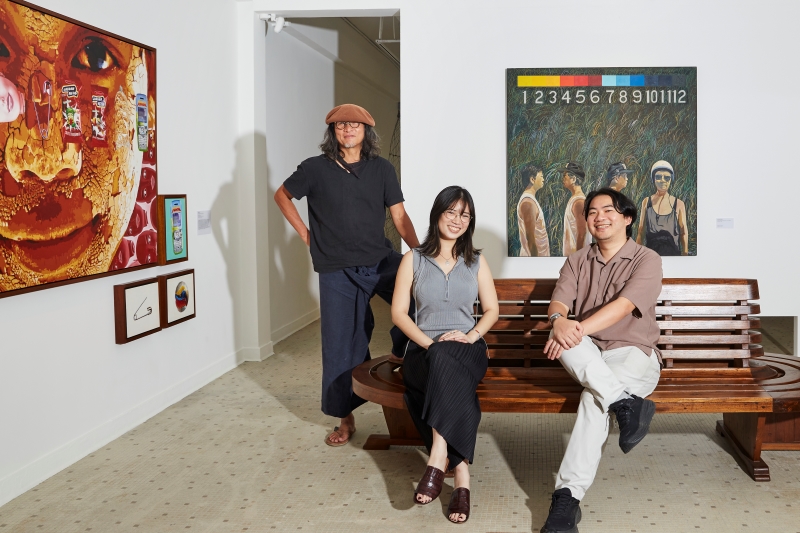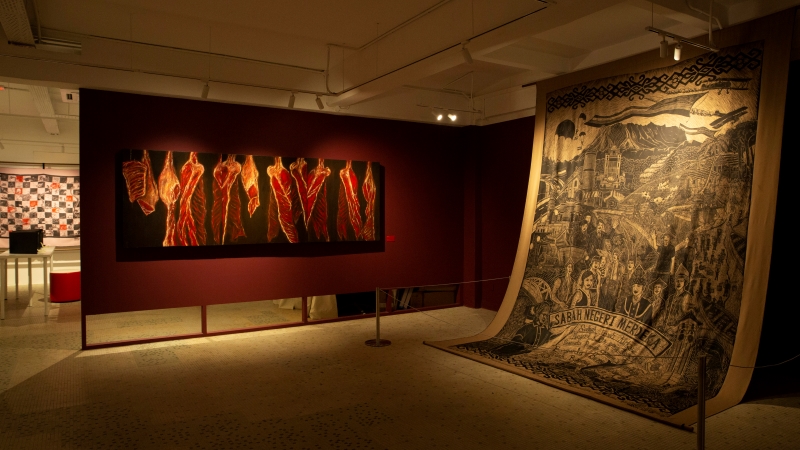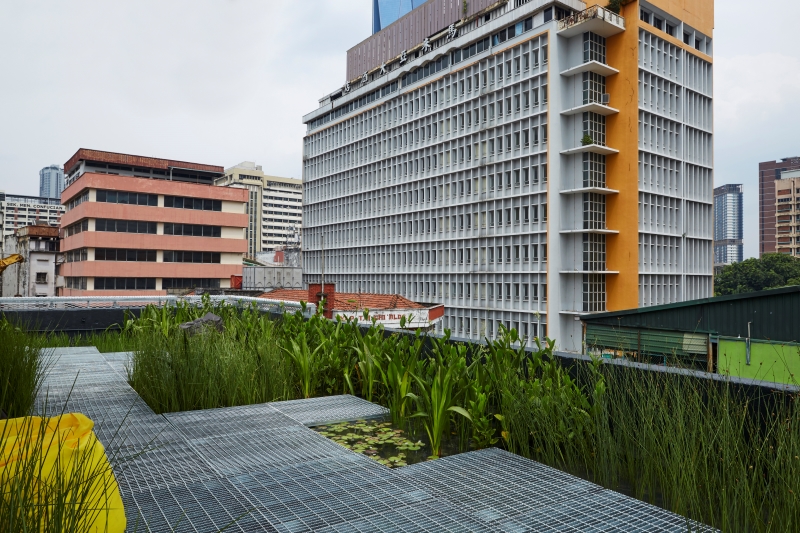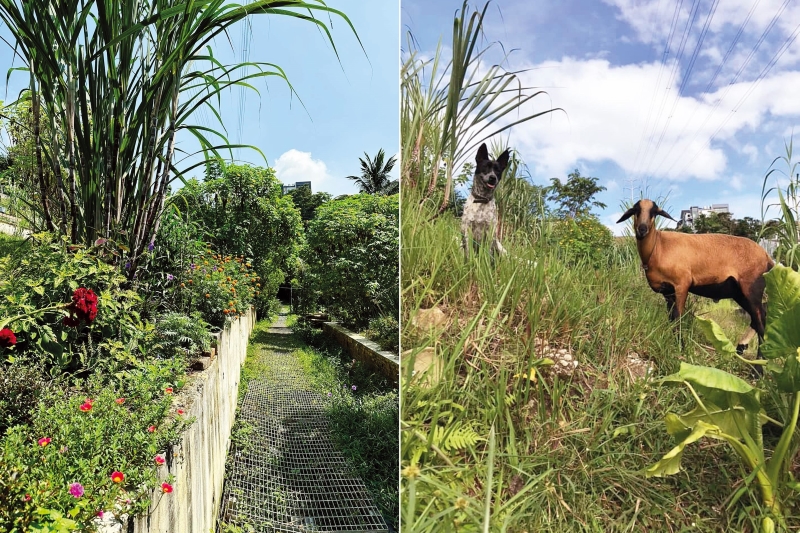
Ng has retired for a number of years now, but looking back, his relationship with landscape architecture “changed in a very spiritual way and became simpler and simpler” (Photo: SooPhye)
Art collecting is a profoundly personal, often lifelong, pursuit. For Ng Seksan, the adroit landscape architect who has dedicated his career to attenuating the urban sprawl’s ecological imbalance, the bug bit hard in 1994. After spending 12 years in New Zealand studying and working, then hustling in Singapore for four, he returned home and established his firm Seksan Design that same year.
“I was always interested in the arts. When I came back to Malaysia, I wanted to buy contemporary works. My company set up a manifesto that we would spend 10% of our profits every year to buy artwork and support young, emerging artists,” shares the Ipoh-born Ng, though he admits some years the amount would creep up to 50%.
“My first piece was by Bayu Utomo Radjikin. I was an activist, and his show really appealed to me as he touched on the suffering in Afghanistan, Vietnam, Africa and things like that. I thought for many days before purchasing because I’d never bought a work so expensive. It was RM4,000.”
Three decades later, Ng has amassed around 700 pieces. He describes himself as an eclectic collector and is drawn to unsettling art many might not have the appetite to hang on their walls. “My house is filled with really difficult, dark and painful art, but I’m okay with it. These are works that appeal to me.”
as1a4392a.jpg

The art of speaking out
Afgan (1995), Ng’s first acquisition, is part of the some 70 pieces from his collection currently on display at the newly minted Ur-Mu 3 along Jalan Tun H S Lee, Kuala Lumpur. An abbreviation of Urban Museum, Ur-Mu is a cluster of private contemporary art galleries owned by architect, fellow art lover and friend, Dr Tan Loke Mun.
“We go to art fairs together very often. On the plane during one of these trips, he said, ‘I just bought a building, would you like to put your collection in it?’ I wasn’t very sure at the time, but I thought these works deserved a bigger audience, so that was one motivation. The other was my interest to see more culture in our city. His model of Ur-Mu fascinated me and sounded like a decentralised museum spreading across KL. That’s why I agreed to lend my works to him,” he shares.
Ong Kar Jin and Lim Sheau Yun — co-founders of bookmaker Cloud Projects — were brought on as curators for the exhibition. “Because I’m very interested in social change, a lot of what I collected is related to that topic. I requested them to maybe have a look and see whether we could have a Reformasi show at the time, but of course they took it further. Now it is called Strategies of Dissent, which explores how artists, from the 1990s until now, find ways of protesting, especially in Malaysia.
“We wanted two things in particular: To expand the idea of what it means to dissent and highlight the cross influences between regions,” explains Ong, who writes and researches about culture and technology. “There are some very loud, stick-it-up-to-the-big-man kind of works. The general audience’s perception of Malaysian political art is often related to Fahmi Reza or Zunar — very satirical. But there’s also a lot of work here that might seem very calm, but are dissenting in their own way through layered meanings, allusions, symbolism and myths.
“And it’s not only happening in Malaysia. The word reformasi comes from the Indonesian movement and the yellow in Bersih comes from the people power movement in the Philippines. What we experienced was regional.”
as1a4402a.jpg

The exhibition, which will go on for at least a year, covers three floors, starting with a level dipped in crimson. The artworks here are impassioned, angry, rebellious and direct, depicting the emotions that typically come to mind when one thinks about the act of protesting.
Among them are creations from the original members of the Matahati collective — Bayu, Ahmad Fuad Osman, Ahmad Shukri Mohamed, Hamir Soib Mohamed, Kamal Ariffin Kamisan, Masnoor Ramli Mahmud and Soraya Yusof Talismail — all fellow students at Universiti Teknologi Mara. They were pivotal figures in the 1990s, employing art to satirise and critique the prevailing political climate.
Moving up, subtler forms of dissent are introduced through metaphors, symbols and abstraction. “One example we always talk about is the PKR flag, which was actually designed by Syed Ahmad Jamal based on Anwar’s (Datuk Seri Anwar Ibrahim) black eye. It became a galvanising symbol for the Reformasi movement,” notes Lim, a designer and researcher on art and architecture. The featured artists expressed themselves by playing with iconography, which in turn produced new meanings over time. “They serve as mirrors of society, but are also active agents and instigators of change in pushing things forward.”
The top floor serves as a reflective space to sober up and consider the different perspectives that construct our common experience. Even quiet, everyday acts of resistance carry significance. “Ultimately, one’s relationship to the political environment is very personal, whether expressed angrily, craftily or subconsciously. I think what we’re trying to help people understand is that articulating in different ways is more than enough,” Lim continues.
Being able to bring all these diverse opinions and perspectives together underscores the fact that private collectors and galleries play a cardinal role in supporting the local art ecosystem. “Some collectors want to have sure bets. They view it as an investment and think of resale value,” Ong notices. “An important thing Seksan and others of his generation have done is that they made a conscious choice to buy young, emerging artists’ work, and did so through galleries and art shows instead of the secondary market.”
Ng hopes the exhibition will inform the younger crowd about the Reformasi period. “I think a lot of my children’s generation don’t know anything about it. If you talk to them about politics, it may be too hard to understand but the subject is more digestible through art. I’m also very interested in young collectors coming upstream. I want them to think about what they collect.
“I met one the other day and was trying to convince him that he should not collect like me because I started 30 years ago. You should be collecting for the future. My children are actually not interested in paintings nowadays. They’re into video, photography and new media. So I hope, through the exhibition, to have conversations with the next generation of collectors, to support newer, more experimental artists and take the art movement to another level.”
Ng is looking forward to taking part in the gallery’s growth across the city. In fact, he designed the rooftop of Ur-Mu 3. “Initially, I just gave Dr Tan the idea to flood it and turn it into a wetland. I’m a part-time adviser at Think City and we’re very interested in bringing not only more greenery, but a biophilic ecosystem to this area. That means we’re designing with nature, trying to bring back all the wildlife, insects, birds and small animals.
“One of the best habitats for wildlife is water, so that’s the gist upstairs. A hundred per cent of the flat roof is actually filled with water. The decking we were walking on was just placed on top of it. It took three days to put together.”
He plans to introduce guppies and river fish too, creating a relaxed area where guests can plant themselves on bean bags and enjoy the city’s ever-changing skyline.
as1a4355a.jpg

Best of both worlds
Art has always informed Ng’s own work. “As a landscape architect, I was first trained in horticulture, then design. But I wanted my practice to be more art-oriented because it’s more cutting edge, more avant garde. I want my landscape design to be seen as a public artwork rather than just a park or multi-functional garden.
“So my gurus are all artists rather than horticulturalists. It’s people like Martha Schwartz, an American landscape architect trained in fine arts. She used very unusual and unconventional materials, like edible bagels and plastic frogs to compose her landscapes.”
He shares an example of how Penangite and visual artist Wong Hoy Cheong influenced his portfolio. “When I design a public space, I want to communicate with the people who use it. Hoy Cheong relies on text to communicate very abstract ideas to his audience. It’s easy and everybody can have their own connotations.
“I designed a big courtyard at Universiti Telekom in Melaka where the patterning of the plaza was the text from writer Munshi Abdullah’s Hikayat Abdullah talking about the power of education. And of course, there are words like Allah, which you cannot step on. So we elevated it to a podium. These are ideas born from the interaction between two fields.”
The configuration of public spaces impacts and even shapes the way people live. Recalling his involvement in building Putrajaya, Ng thinks the project failed because they got one thing wrong.
“We think architecture or landscaping is just about building beautiful, glamorous and big things. The 4km centre core boulevard is 100m wide and modelled after the Champs-Élysées, but Putrajaya doesn’t have Paris’ population. As landscape architects, we need to get the scale right to make sure that people, whether it’s a big population or small gathering, can feel it is spatially correct. Scale is very important.”
Another lesson he learnt is the importance of “software”. “In the past, we only thought about building, but that doesn’t work anymore. You see many failed shopping centres today because they only emphasised hardware. I’m now beginning to see more importance placed on the roles of placemakers, curators and programmers. Those are vital aspects in our work as city builders.”
Ng has retired for a number of years now, but looking back, his relationship with landscape architecture “changed in a very spiritual way and became simpler and simpler”.
“Initially, there’s always the temptation to add more and more, throwing all the ideas into one project. Nowadays, every project has just one idea. And I think it culminated in Kebun Kebun Bangsar. That is the most important project in my entire career. People think it’s not design, but it is. When design doesn’t look like design, that’s the ultimate.”
kebun_kebun_bangsar.jpg

The green life
The community garden is a prime example of how establishing a biophilic ecosystem in the city can benefit its people. Nevertheless, Ng has gone through his fair share of grievances no thanks to the authorities. Home to animals such as geese, ducks, sheep and cows in addition to lush vegetation, Kebun Kebun Bangsar is free to enter all year.
“I’m there every day, twice a day!” says Ng, who enthusiastically welcomes all to visit. “I have a few favourite spots. I like to hang out in my headquarters where the ducks are or at the sofa area. During the weekends, when my volunteers come, we hang out by the pizza oven.” Community events are often hosted in the gardens, with all of the information available on social media.
Taking care of the 2.5-acre land is a team effort but highly doable, and keeping the city green will ultimately create a healthier, more liveable atmosphere for its people. “One of my major issues with DBKL (Kuala Lumpur City Hall) is the way they manage our assets. We’ve planted so many trees in the last 20 years but we’re destroying more than we’re maintaining,” Ng laments.
“I think we need to be more progressive and informed. We’re competing with international cities. We’re so far behind that catching up is not enough, we need to leapfrog. In order to do that, we need good, young leaders. The old guys think they know it all but they don’t. We need to look to the new generation.
“For too long, our cities have been designed for cars and I think that’s a very wrong strategy. In order to make it more livable, we have to take care of the pedestrians. The next priority will be the cyclists and cars come in last. For pedestrians and slower-moving vehicles, it’s very important that they have an environment where it’s cool, shaded and full of oxygen.”
An avid traveller, Ng thinks cities such as Copenhagen and Amsterdam have got it right. “Places that promote cycling and walking are so pleasant! In this part of the world, I really love Hangzhou, the site that inspired all the poets and writers of ancient China. You want a city that can inspire music and art!”
One thing he has noticed is there are stiffer regulations in landscape architecture now compared with before. “You go to the suburbs and every fence looks the same because the council requires you to do that. Regulation is a double-edged sword. It has to be flexible enough and be addressed on a case-by-case basis. If you standardise everything, it kills creativity. Give some leeway lah. They’re even specifying what trees to plant.”
This can end up being problematic in the long run if the advice is not from experts and there is unchecked development. In May, a large tree outside Concorde Hotel on Jalan Sultan Ismail was uprooted, claiming the life of a 47-year-old man. Less than a week later, another tree fell a stone’s throw away, damaging a police patrol car. Similar incidents occurred in Penang, Alor Setar and Nilai not long after.
One major contributing factor is that a large number of trees planted in our cities are not native to the country. “These foreign species are not acclimatised here. And as most are fast-growing, the roots get very soft and brittle,” Ng shares. He recommends utilising the indigenous trees in our own backyard instead.
“There are a lot of beautiful trees in our forests. The ones I really like have clean, orange or red trunks with peeling bark. And they never get blown down by rain because they’re acclimatised here. If you visit my Sekeping properties (another of Ng’s most rewarding projects) you’ll see Syzygium trees. In Malay, [they are] called kelat nasi.”
Commonly found in our coastal forests, these trees — a relative of the jambu air or rose apple plant — grow up to only five metres, making them very manageable in domestic homes. The hardy trunks (good for climbing and hanging hammocks!) are self-cleaning and peel to a peachy shade. Plus, the cycle of new leaves, white flowers and fruit provide seasonal interest.
Maverick moves
Ng often shares horticultural tips and tricks on social media. More recently, he has been posting anecdotes about his life and short stories.
When asked if an autobiography is in the works, Ng waves it off and says: “I don’t believe in books. A lot of people want to publish my work but I feel like it can only reach a small audience. Some of my friends publish about 2,000 copies. [At] most, you triple it to 6,000 and the book costs RM250. It becomes very inaccessible and students probably cannot afford it. I like social media. It’s accessible throughout the world.
“I try to take a more unconventional view on everything in life. If you look at some of the visionaries in the world, such as Warren Buffett or Elon Musk, the contrarians make life more interesting for everybody. I usually don’t like to give advice because I’ve made so many mistakes. But one thing I can say is be a contrarian — go against the grain.”
This ethos aptly describes Ng’s approach to both art and landscape architecture, but it is also embedded in his current lifestyle. If not the garden or gallery, one can most probably find him at the mamak stall having roti canai and teh tarik.
“When I retired, I told myself I can survive if I downgrade my lifestyle. I started cycling so I don’t have to spend so much on petrol and I sew my own clothes.”
Asked about the benefits of living life simply, Ng replies in a heartbeat: “So that others can simply live. We can share our resources with more people. That’s the philosophy I believe in.”
This article first appeared on Sept 30, 2024 in The Edge Malaysia.


